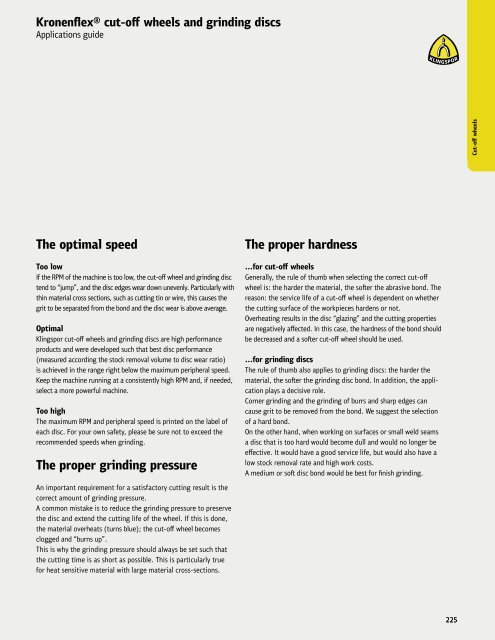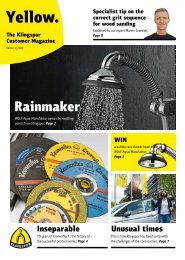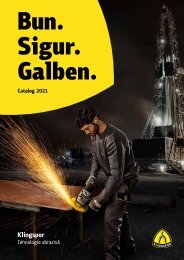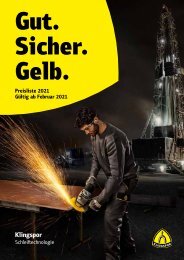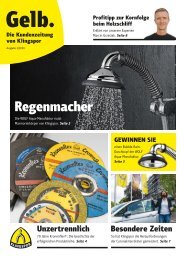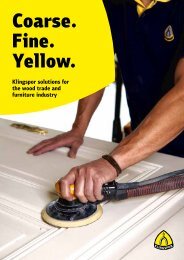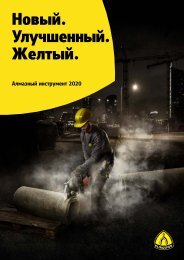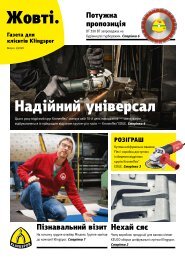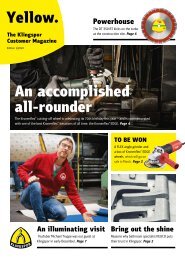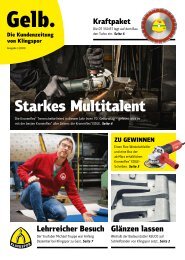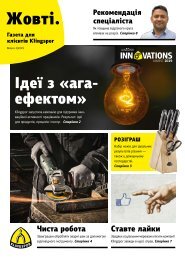- Page 1 and 2:
Quality. Safety. Performance. Catal
- Page 3 and 4:
General Information Contents 3 Coat
- Page 5 and 6:
General Information Product overvie
- Page 7 and 8:
General Information Machine pictogr
- Page 9 and 10:
Product guide Coated abrasives Page
- Page 11 and 12:
Product guide Coated abrasives Page
- Page 13 and 14:
Product guide Coated abrasives Page
- Page 15 and 16:
Coated abrasives Applications guide
- Page 17 and 18:
Coated abrasives Applications guide
- Page 19 and 20:
Rolls Application Type Grain Backin
- Page 21 and 22:
Rolls with paper backing Coated abr
- Page 23 and 24:
Rolls with cloth backing Coated abr
- Page 25 and 26:
Rolls with cloth backing Coated abr
- Page 27 and 28:
Rolls with cloth backing Coated abr
- Page 29 and 30:
Rolls with cloth backing Coated abr
- Page 31 and 32:
Rolls, non-woven web Non-woven web
- Page 33 and 34:
Rolls, foam Abrasive paper with foa
- Page 35 and 36:
Abrasive belts About the product Ap
- Page 37 and 38:
Abrasive belts Applications guide A
- Page 39 and 40:
Belts with paper backing Coated abr
- Page 41 and 42:
Belts with paper / film / cloth bac
- Page 43 and 44:
Belts with cloth backing Coated abr
- Page 45 and 46:
Belts with cloth backing Coated abr
- Page 47 and 48:
Belts with cloth backing Coated abr
- Page 49 and 50:
Belts with cloth backing Coated abr
- Page 51 and 52:
Belts with cloth backing Coated abr
- Page 53 and 54:
Belts with cloth backing Coated abr
- Page 55 and 56:
Belts with cloth backing Coated abr
- Page 57 and 58:
Belts with cloth backing Coated abr
- Page 59 and 60:
Belts with cloth backing Coated abr
- Page 61 and 62:
Belts with cloth backing Coated abr
- Page 63 and 64:
Belts with cloth backing Coated abr
- Page 65 and 66:
Belts with cloth backing Coated abr
- Page 67 and 68:
Belts with cloth backing Coated abr
- Page 69 and 70:
Belts with cloth backing Coated abr
- Page 71 and 72:
Non-woven web belts Non-woven web b
- Page 73 and 74:
Wide belts Applications guide Belt
- Page 75 and 76:
Wide belts with paper backing Coate
- Page 77 and 78:
Wide belts with paper backing Coate
- Page 79 and 80:
Wide belts with paper backing Coate
- Page 81 and 82:
Wide belts with cloth backing Coate
- Page 83 and 84:
Wide belts with cloth backing Coate
- Page 85 and 86:
Wide belts with cloth backing Coate
- Page 87 and 88:
Wide belts with cloth backing Coate
- Page 89 and 90:
Strips/Sheets/Discs About the produ
- Page 91 and 92:
Strips/Sheets/Discs Applications gu
- Page 93 and 94:
Sheets with paper backing Coated ab
- Page 95 and 96:
Sheets with paper backing Coated ab
- Page 97 and 98:
Sheets with paper backing Coated ab
- Page 99 and 100:
Sheets with paper backing Coated ab
- Page 101 and 102:
Strips with paper backing, self-fas
- Page 103 and 104:
Hand block Hand block HK 100 NEW !
- Page 105 and 106:
Sheets with cloth backing Coated ab
- Page 107 and 108:
Non-woven web hand pads Non-woven w
- Page 109 and 110:
Abrasive block Abrasive block, flex
- Page 111 and 112:
Abrasive sponge Abrasive sponge, fl
- Page 113 and 114:
Abrasive screen Abrasive screen, se
- Page 115 and 116:
Discs Applications guide Hole patte
- Page 117 and 118:
Discs with paper backing / Abrasive
- Page 119 and 120:
Discs with paper backing, self-fast
- Page 121 and 122:
Discs with paper backing, self-fast
- Page 123 and 124:
Discs with paper backing, self-fast
- Page 125 and 126:
Discs with paper backing, self-fast
- Page 127 and 128:
Discs with paper backing, self-fast
- Page 129 and 130:
Discs with paper backing, self-fast
- Page 131 and 132:
Discs with paper / film backing, se
- Page 133 and 134:
Discs with paper backing, self-fast
- Page 135 and 136:
Discs with paper backing, self-fast
- Page 137 and 138:
Back-up pads Coated abrasives Back-
- Page 139 and 140:
Discs with paper backing, self-fast
- Page 141 and 142:
Discs with cloth backing, self-adhe
- Page 143 and 144:
Discs, non-woven web Non-woven web
- Page 145 and 146:
Discs with foam backing Grinding di
- Page 147 and 148:
Quick Change Discs About the produc
- Page 149 and 150:
Quick Change Discs Applications gui
- Page 151 and 152:
Quick Change Discs Quick Roll Conne
- Page 153 and 154:
Quick Change Discs Quick Roll Conne
- Page 155 and 156:
Quick Change Discs Quick Metal Conn
- Page 157 and 158:
Quick Change Discs Quick Metal Conn
- Page 159 and 160:
Quick Change Discs Quick Metal Conn
- Page 161 and 162:
Quick Disc Connect Quick Disc Conne
- Page 163 and 164:
Small abrasive mop About the produc
- Page 165 and 166:
Small abrasive mop Abrasive mop Sma
- Page 167 and 168:
Small abrasive mop Abrasive mop Co
- Page 169 and 170:
Small abrasive mop Abrasive mop Sma
- Page 171 and 172:
Notes Abrasive mop 171
- Page 173 and 174: Abrasive mop wheels Applications gu
- Page 175 and 176: Abrasive mop wheels Applications gu
- Page 177 and 178: Abrasive mop wheels Abrasive mop Ab
- Page 179 and 180: Abrasive mop wheels Abrasive mop Ab
- Page 181 and 182: Finishing mop Abrasive mop Abrasive
- Page 183 and 184: Abrasive flap drums Abrasive mop Sa
- Page 185 and 186: Abrasive flap drums / Adapter for s
- Page 187 and 188: Fibre discs About the product Kling
- Page 189 and 190: Fibre discs Coated abrasives Conti
- Page 191 and 192: Fibre discs Coated abrasives Abrasi
- Page 193 and 194: Fibre discs Coated abrasives Abrasi
- Page 195 and 196: Back-up pads / Dispenser Back-up pa
- Page 197 and 198: Abrasive mop disc About the product
- Page 199 and 200: Abrasive mop disc Applications guid
- Page 201 and 202: Abrasive mop disc SMT programme Ste
- Page 203 and 204: Abrasive mop discs Abrasive mop dis
- Page 205 and 206: Abrasive mop discs Abrasive mop dis
- Page 207 and 208: Abrasive mop discs Abrasive mop dis
- Page 209 and 210: Abrasive mop discs Abrasive mop dis
- Page 211 and 212: Abrasive mop discs Abrasive mop dis
- Page 213 and 214: Abrasive mop discs Abrasive mop dis
- Page 215 and 216: High performance non-woven web whee
- Page 217 and 218: Abrasive mop discs Abrasive mop dis
- Page 219 and 220: Power Wheel Abrasive mop discs Powe
- Page 221 and 222: Kronenflex® cut-off wheels and gri
- Page 223: Kronenflex® cut-off wheels and gri
- Page 227 and 228: Kronenflex® cut-off wheels and gri
- Page 229 and 230: Kronenflex® cut-off wheels and gri
- Page 231 and 232: Kronenflex® large cut-off wheels A
- Page 233 and 234: Kronenflex® cut-off wheels for han
- Page 235 and 236: Kronenflex® cut-off wheels for han
- Page 237 and 238: Kronenflex® cut-off wheels for han
- Page 239 and 240: Kronenflex® cut-off wheels for han
- Page 241 and 242: Kronenflex® cut-off wheels for han
- Page 243 and 244: Kronenflex® small cut-off wheel fo
- Page 245 and 246: Kronenflex® large cut-off wheels f
- Page 247 and 248: Kronenflex® large cut-off wheels f
- Page 249 and 250: Kronenflex® large cut-off wheels f
- Page 251 and 252: Notes Cut-off wheels 251
- Page 253 and 254: Kronenflex® grinding discs About t
- Page 255 and 256: Kronenflex® grinding discs for han
- Page 257 and 258: Kronenflex® grinding discs for han
- Page 259 and 260: Kronenflex® grinding discs for han
- Page 261 and 262: Kronenflex® cup grinding wheels fo
- Page 263 and 264: Notes Grinding discs 263
- Page 265 and 266: Diamond tools Remain in full contro
- Page 267 and 268: Diamond tools Applications guide 1.
- Page 269 and 270: Diamond tools Applications guide Nu
- Page 271 and 272: Diamond cutting blades for angle gr
- Page 273 and 274: Diamond cutting blades for angle gr
- Page 275 and 276:
Diamond cutting blades for angle gr
- Page 277 and 278:
Diamond cutting blades for angle gr
- Page 279 and 280:
Diamond cutting blades for angle gr
- Page 281 and 282:
Diamond cutting blades for angle gr
- Page 283 and 284:
Diamond cup grinding wheels for ang
- Page 285 and 286:
Diamond cup grinding wheels for ang
- Page 287 and 288:
Diamond cutting blades for petrol p
- Page 289 and 290:
Diamond cutting blades for table sa
- Page 291 and 292:
Diamond cutting blades for petrol p
- Page 293 and 294:
Diamond cutting blades for joint cu
- Page 295 and 296:
Diamond cutting blades for petrol p
- Page 297 and 298:
Diamond cutting blades for petrol p
- Page 299 and 300:
Reduction rings Reduction rings DZ
- Page 301 and 302:
Drill bit segments for DK 654 and D
- Page 303 and 304:
Hole starting aid Hole starting aid
- Page 305 and 306:
Flexible abrasives About the produc
- Page 307 and 308:
Flexible abrasives Mounted points,
- Page 309 and 310:
Flexible abrasives Hand block Hand
- Page 311 and 312:
Carbide burrs About the product Pow
- Page 313 and 314:
Carbide burrs Carbide burr SB-NF Ap
- Page 315 and 316:
Carbide burrs Carbide burr SC-DC Ap
- Page 317 and 318:
Carbide burrs Carbide burr SF-INOX
- Page 319 and 320:
Carbide burrs Carbide burr SG-DC Ap
- Page 321 and 322:
Carbide burrs Carbide burr SL-DC Ap
- Page 323 and 324:
D.I.Y. range The new Klingspor D.I.
- Page 325 and 326:
D.I.Y. range Continuation of LS 30
- Page 327 and 328:
D.I.Y. range Abrasive paper, waterp
- Page 329 and 330:
D.I.Y. range Abrasive paper, self-f
- Page 331 and 332:
D.I.Y. range Abrasive paper, self-f
- Page 333 and 334:
Safety recommendations Applications
- Page 335 and 336:
General Terms and Conditions of Tra
- Page 337 and 338:
Notes 337 Service
- Page 339 and 340:
Klingspor N.V. / S.A. Herent, Belgi


